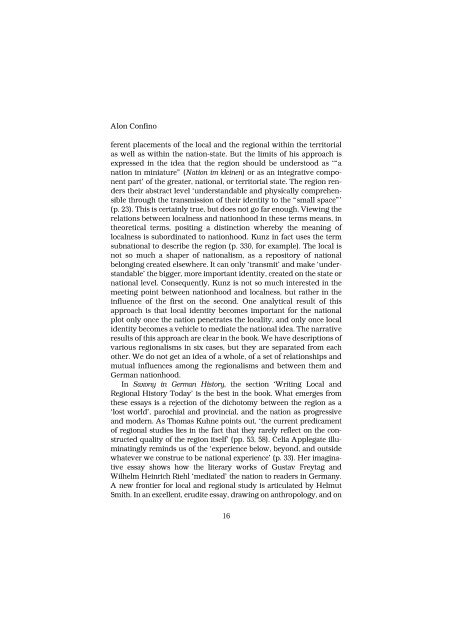Download - German Historical Institute London
Download - German Historical Institute London
Download - German Historical Institute London
Create successful ePaper yourself
Turn your PDF publications into a flip-book with our unique Google optimized e-Paper software.
Alon Confino<br />
ferent placements of the local and the regional within the territorial<br />
as well as within the nation-state. But the limits of his approach is<br />
expressed in the idea that the region should be understood as ‘“a<br />
nation in miniature” (Nation im kleinen) or as an integrative component<br />
part’ of the greater, national, or territorial state. The region renders<br />
their abstract level ‘understandable and physically comprehensible<br />
through the transmission of their identity to the “small space”’<br />
(p. 23). This is certainly true, but does not go far enough. Viewing the<br />
relations between localness and nationhood in these terms means, in<br />
theoretical terms, positing a distinction whereby the meaning of<br />
localness is subordinated to nationhood. Kunz in fact uses the term<br />
subnational to describe the region (p. 330, for example). The local is<br />
not so much a shaper of nationalism, as a repository of national<br />
belonging created elsewhere. It can only ‘transmit’ and make ‘understandable’<br />
the bigger, more important identity, created on the state or<br />
national level. Consequently, Kunz is not so much interested in the<br />
meeting point between nationhood and localness, but rather in the<br />
influence of the first on the second. One analytical result of this<br />
approach is that local identity becomes important for the national<br />
plot only once the nation penetrates the locality, and only once local<br />
identity becomes a vehicle to mediate the national idea. The narrative<br />
results of this approach are clear in the book. We have descriptions of<br />
various regionalisms in six cases, but they are separated from each<br />
other. We do not get an idea of a whole, of a set of relationships and<br />
mutual influences among the regionalisms and between them and<br />
<strong>German</strong> nationhood.<br />
In Saxony in <strong>German</strong> History, the section ‘Writing Local and<br />
Regional History Today’ is the best in the book. What emerges from<br />
these essays is a rejection of the dichotomy between the region as a<br />
‘lost world’, parochial and provincial, and the nation as progressive<br />
and modern. As Thomas Kuhne points out, ‘the current predicament<br />
of regional studies lies in the fact that they rarely reflect on the constructed<br />
quality of the region itself’ (pp. 53, 58). Celia Applegate illuminatingly<br />
reminds us of the ‘experience below, beyond, and outside<br />
whatever we construe to be national experience’ (p. 33). Her imaginative<br />
essay shows how the literary works of Gustav Freytag and<br />
Wilhelm Heinrich Riehl ‘mediated’ the nation to readers in <strong>German</strong>y.<br />
A new frontier for local and regional study is articulated by Helmut<br />
Smith. In an excellent, erudite essay, drawing on anthropology, and on<br />
16













